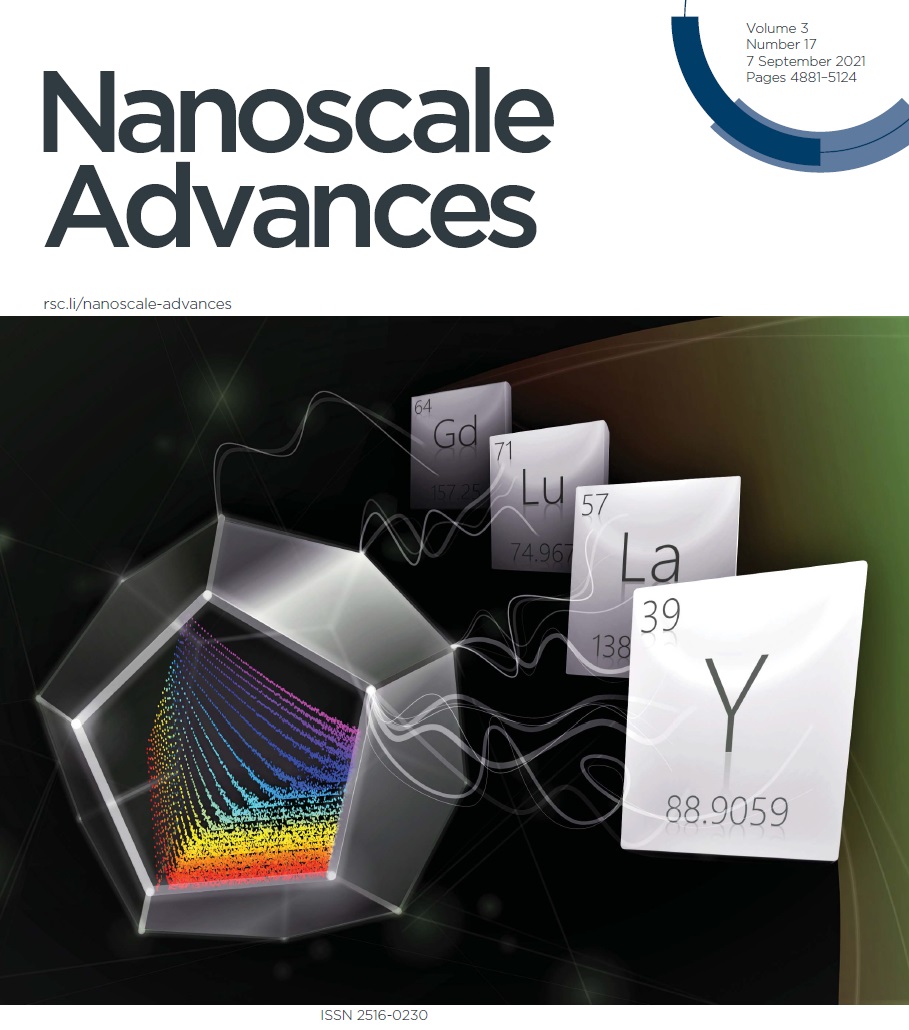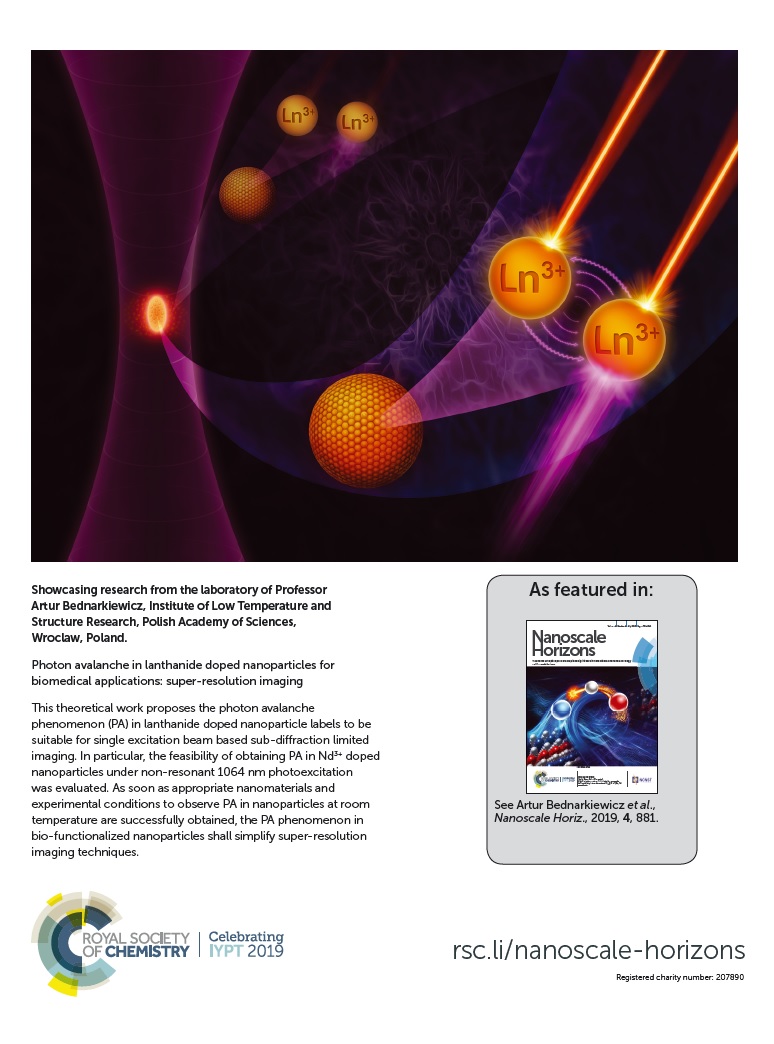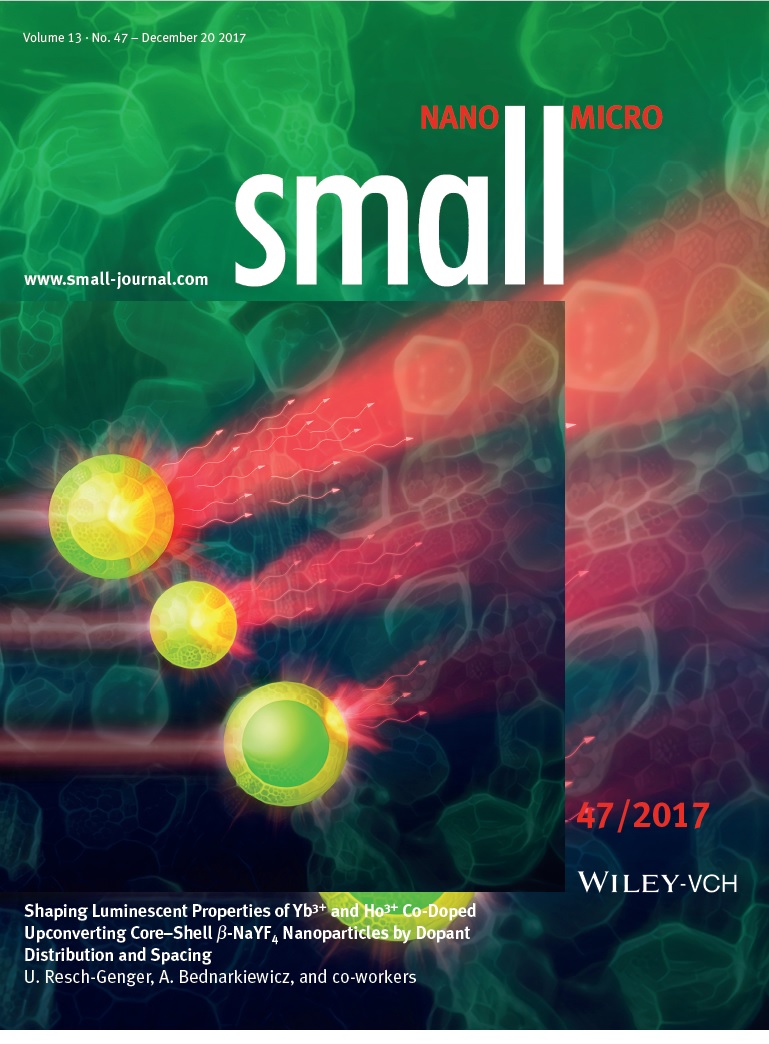Journal cover pages WEB of Fame
We have, indyvidually and jointly, co-authored a few cover pages.

| Cover image | Title & details |
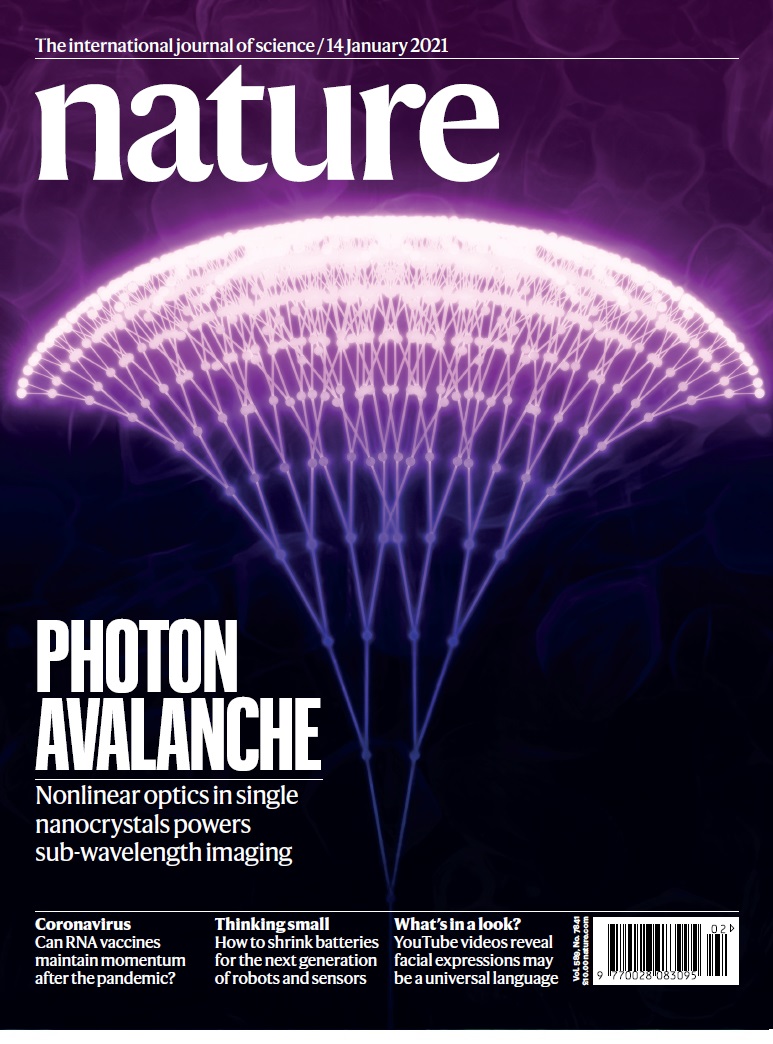 |
Giant nonlinear optical responses from photon-avalanching nanoparticles, Changhwan Lee, Emma Z. Xu, Yawei Liu, Ayelet Teitelboim, Kaiyuan Yao, Angel Fernandez-Bravo, Agata M. Kotulska, Sang Hwan Nam, Yung Doug Suh*, Artur Bednarkiewicz*, Bruce E. Cohen*, Emory M. Chan* & P. James Schuck* Avalanche phenomena use steeply nonlinear dynamics to generatedisproportionately large responses from small perturbations, and are found in a multitude of events and materials. Photon avalanching enables technologies such as optical phase-conjugate imaging, infrared quantum counting and efficient upconverted lasing. However, the photon-avalanching mechanism underlying these optical applications has been observed only in bulk materials and aggregates limiting its utility and impact. Here we report the realization of photon avalanching at room temperature in single nanostructures—small, Tm3+-doped upconverting nanocrystals—and demonstrate their use in super-resolution imaging in near-infrared spectral windows of maximal biological transparency. Avalanching nanoparticles (ANPs) can be pumped by continuous-wave lasers, and exhibit all of the defining features of photon avalanching, including clear excitation-power thresholds, exceptionally long rise time at threshold, and a dominant excited-state absorption that is more than 10,000 times larger than ground-state absorption. Beyond the avalanching threshold, ANP emission scales nonlinearly with the 26th power of the pump intensity, owing to induced positive optical feedback in each nanocrystal. This enables the experimental realization of photon-avalanche single-beam super-resolution imaging with sub-70-nanometre spatial resolution, achieved by using only simple scanning confocal microscopy and without any computational analysis. Pairing their steep nonlinearity with existing super-resolution techniques and computational methods, ANPs enable imaging with higher resolution and at excitation intensities about 100 times lower than other probes. The low photon-avalanching threshold and excellent photostability of ANPs also suggest their utility in a diverse array of applications, including sub-wavelength imaging and optical and environmental sensing. Nature, 592 (2021) 7841. https://doi.org/10.1038/s41586-020-03092-9 |
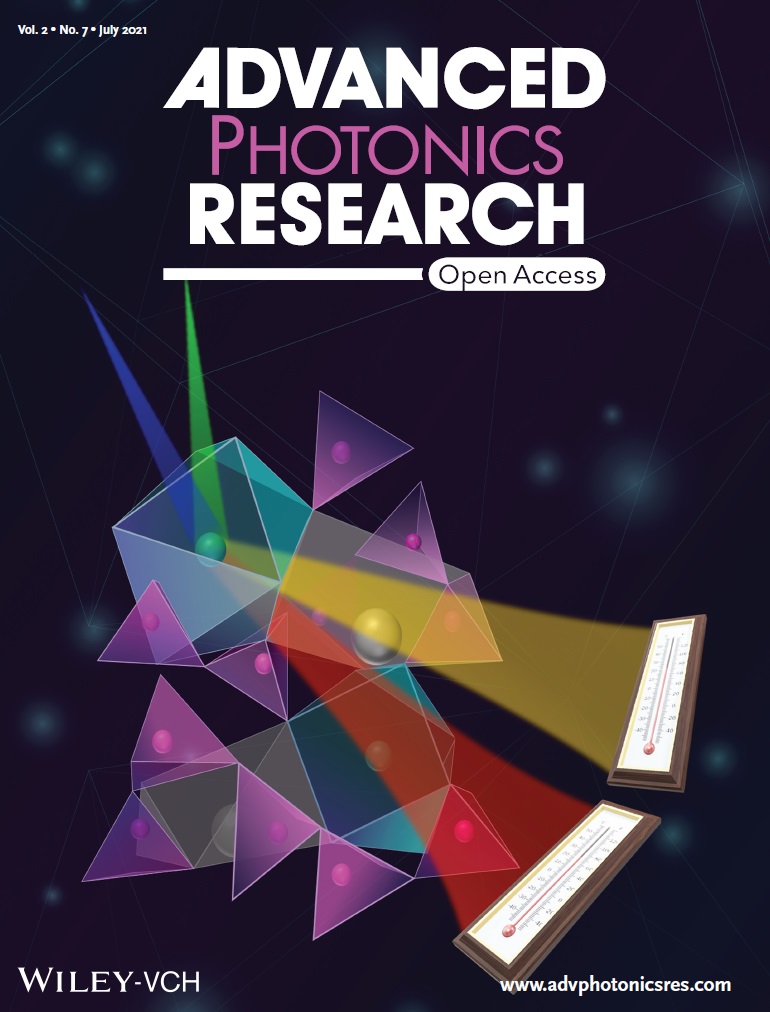 |
Single-Band Ratiometric Luminescent Thermometry Using Pr3+ Ions Emitting in Yellow and Red Spectral Ranges, Joanna Stefanska*, Lukasz Marciniak* The possibility of using Pr3+ ions to develop multicolor-emission-based luminescence thermometry in a single-band-ratiometric configuration is investigated for the first time. The thermally induced decrease in intensities of 3P0 → 3F2 and 1D2 → 3H4 emission bands is demonstrated using the excitation matching the ground-state absorption, and an inverse relation is obtained using the optical excitation matching the excited-state absorption. The strategy of modulation of the thermometric properties of the Pr3+-based red- and yellow-emitting single-band ratiometric (SBR) luminescent thermometers by the activation of the cross-relaxation (CR) phenomenon promoted by the dopant concentration is elaborated. Contrary to expectations, the {3P0, 3H4} ↔ {1D2, 3H6} CR process is shown to cause the high and low dopant concentrations to be optimal for highly sensitive SBR luminescent thermometers operating in the red and yellow spectral ranges, respectively. In both cases, high relative sensitivities of the temperature readout are obtained. These results make Pr3+ ions promising candidates for a SBR thermometry approach. Advanced Photonics Research 2(2021) 2100070. https://doi.org/10.1002/adpr.202100070 |
|
|
NIR luminescence lifetime nanothermometry based on phonon assisted Yb3+–Nd3+ energy transfer, Kamila Maciejewska, Artur Bednarkiewicz, Lukasz Marciniak Luminescence thermometry in biomedical sciences is a highly desirable, but also highly challenging and demanding technology. Numerous artifacts have been found during steady-state spectroscopy temperature quantification, such as ratiometric spectroscopy. Oppositely, the luminescence lifetime is considered as the most reliable indicator of temperature thermometry because this luminescent feature is not susceptible to sample properties or luminescence reabsorption by the nanothermometers themselves. Unfortunately, this type of thermometer is much less studied and known. Here, the thermometric properties of Yb3+ ions in Nd0.5RE0.4Yb0.1PO4 luminescent temperature probes were evaluated, aiming to design and optimize luminescence lifetime based nanothermometers. Temperature dependence of the luminescence lifetimes is induced by thermally activated phonon assisted energy transfer from the 2F5/2 state of Yb3+ ions to the 4F3/2 state of Nd3+ ions, which in turn is responsible for the significant quenching of the Yb3+:2F5/2 lifetime. It was also found that the thermal quenching and thus the relative sensitivity of the luminescent thermometer can be intentionally altered by the RE ions used (RE = Y, Lu, La, and Gd). The highest relative sensitivity was found to be SR = 1.22% K−1 at 355 K for Nd0.5Y0.4Yb0.1PO4 and it remains above 1% K−1 up to 500 K. The high sensitivity and reliable thermometric performance of Nd0.5La0.4Yb0.1PO4 were confirmed by the high reproducibility of the temperature readout and the temperature uncertainty being as low as δT = 0.05 K at 383 K. Nanoscale Advances 3(2021) 4918-4925. https://doi.org/10.1039/D1NA00285F |
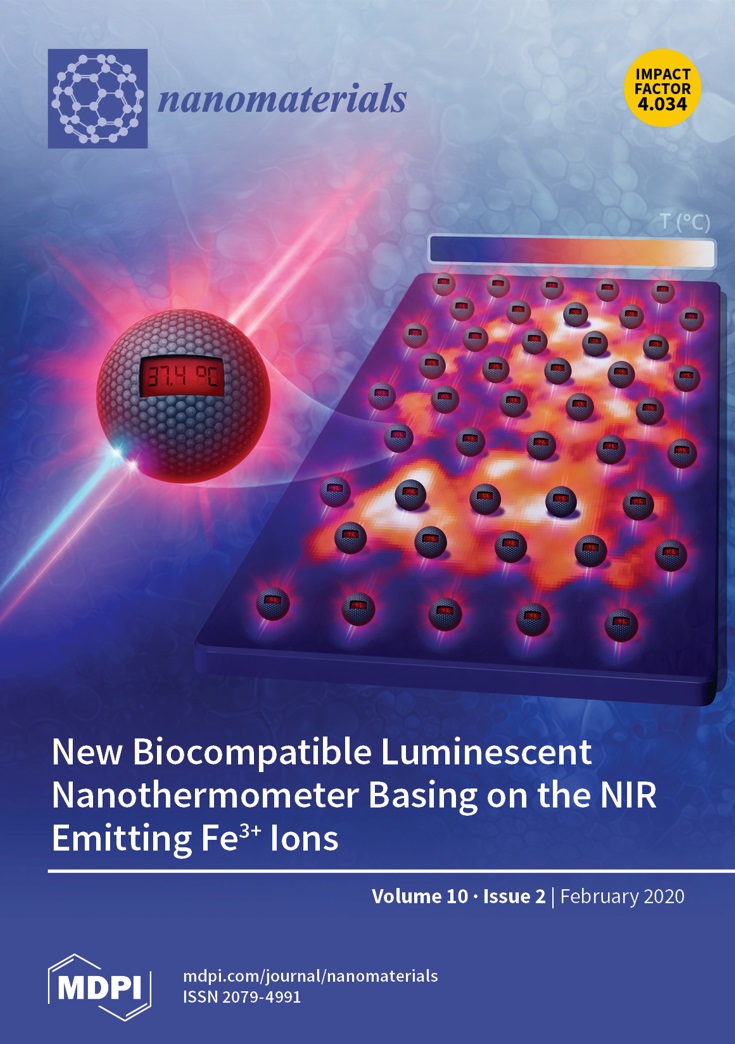 |
LiAl5O8:Fe3+ and LiAl5O8:Fe3+, Nd3+ as a New Luminescent Nanothermometer Operating in 1st Biological Optical Window, Karolina Kniec*, Marta Tikhomirov, Blazej Pozniak, Karolina Ledwa, Lukasz Marciniak* New types of contactless luminescence nanothermometers, namely, LiAl5O8:Fe3+ and LiAl5O8:Fe3+, Nd3+ are presented for the first time, revealing the potential for applications in biological systems. The temperature-sensing capability of the nanocrystals was analyzed in wide range of temperature (−150 to 300 °C). The emission intensity of the Fe3+ ions is affected by the change in temperature, which induces quenching of the 4T1 (4G) → 6A1 (6S) Fe3+ transition situated in the 1st biological window. The highest relative sensitivity in the temperature range (0 to 50 °C) was found to be 0.82% °C (at 26 °C) for LiAl5O8: 0.05% Fe3+ nanoparticles that are characterized by long luminescent lifetime of 5.64 ms. In the range of low and high temperatures the Smax was calculated for LiAl5O8:0.5% Fe3+ to be 0.92% °C at −100 °C and for LiAl5O8:0.01% Fe3+ to be 0.79% °C at 150 °C. The cytotoxicity assessment carried out on the LiAl5O8:Fe3+ nanocrystals, demonstrated that they are biocompatible and may be utilized for in vivo temperature sensing. The ratiometric luminescent nanothermometer, LiAl5O8:Fe3+, Nd3+, which was used as a reference, possesses an Smax = 0.56%/°C at −80 °C, upon separate excitation of Fe3+ and Nd3+ ions using 266 nm and 808 nm light, respectively. Nanomaterials 10 (2020) 189. https://doi.org/10.3390/nano10020189 |
|
|
Photon avalanche in lanthanide doped nanoparticles for biomedical applications: super-resolution imaging, Artur Bednarkiewicz*, Emory M. Chan, Agata Kotulska, Lukasz Marciniak and Katarzyna Prorok Confocal fluorescence microscopy is a powerful tool for visualizing biological processes, but conventional laser scanning confocal microscopy cannot resolve structures below the diffraction limit of light. Although numerous sub-diffraction imaging techniques have been developed over the last decade, they are still limited by the photobleaching of fluorescent probes and by their complex instrumentation and alignment procedures. To address these issues, we propose a novel concept that relies on using photon avalanche (PA) anti-Stokes emission nanoparticles as luminescent labels. This technique leverages the highly non-linear relationship between photoluminescence intensity and excitation intensity observed with PA, which narrows the point spread function below 50 nm when the non-linearity exceeds 50. Using theoretical modelling, we evaluate the feasibility of obtaining PA in Nd3+ doped nanoparticles under non-resonant 1064 nm photoexcitation and study the impact of phenomenological parameters, such as photoexcitation intensity, concentration of dopants or features of the host matrix, on the theoretical PA behavior. Using these optimized parameters, our simulations resolved 20-nm features using nonlinear orders of 80. These predictions require experimental proof of concept, which must be preceded by development of appropriate PA nanomaterials and experimental conditions to observe PA in nanoparticles at room temperature. When successful, the PA phenomenon in bio-functionalized nanoparticles shall radically simplify the technical means for super-resolution imaging. Nanoscale Horizon (2019), 4, 881. https://DOI: 10.1039/c9nh00089e |
|
|
Shaping Luminescent Properties of Yb3+ and Ho3+ Co-Doped Upconverting Core–Shell β-NaYF4 Nanoparticles by Dopant Distribution and Spacing Aleksandra Pilch, Christian Würth, Martin Kaiser, Dominika Wawrzyńczyk, Michalina Kurnatowska, Sebastian Arabasz, Katarzyna Prorok, Marek Samoć, Wiesław Strek, Ute Resch-Genger,* and Artur Bednarkiewicz* At the core of luminescence color and lifetime tuning of rare earth doped upconverting nanoparticles (UCNPs), is the understanding of the impact of the particle architecture for commonly used sensitizer (S) and activator (A) ions. In this respect, a series of core @ shell NaYF4 UCNPs doped with Yb3+ and Ho3+ ions are presented here, where the same dopant concentrations are distributed in different particle architectures following the scheme: YbHo core and YbHo@…, …@YbHo, Yb@Ho, Ho@Yb, YbHo@Yb, and Yb@YbHo core–shell NPs. As revealed by quantitative steady-state and time-resolved luminescence studies, the relative spatial distribution of the A and S ions in the UCNPs and their protection from surface quenching has a critical impact on their luminescence characteristics. Although the increased amount of Yb3+ ions boosts UCNP performance by amplifying the absorption, the Yb3+ ions can also efficiently dissipate the energy stored in the material through energy migration to the surface, thereby reducing the overall energy transfer efficiency to the activator ions. The results provide yet another proof that UC phosphor chemistry combined with materials engineering through intentional core@shell structures may help to fine-tune the luminescence features of UCNPs for their specific future applications in biosensing, bioimaging, photovoltaics, and display technologies. Small (2017) 1701635 https://doi.org/10.1002/smll.201701635 |
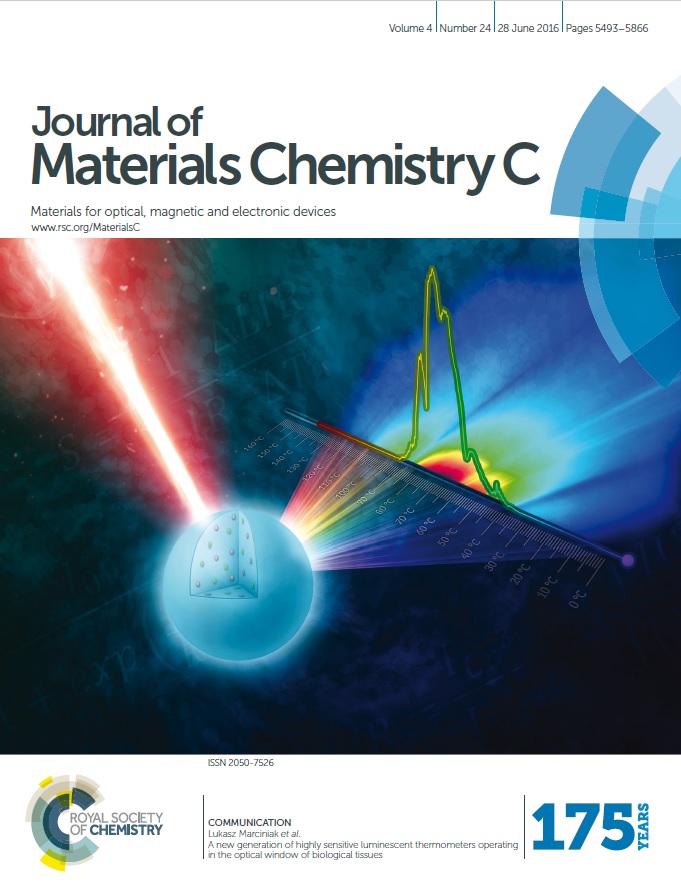 |
A new generation of highly sensitive luminescent thermometers operating in the optical window of biological tissues, Lukasz Marciniak*, Artur Bednarkiewicz, Diana Kowalska, Wieslaw Strek A new type of luminescent thermometer based on highly temperature dependent d–d Cr3+ transitions related to barely temperature dependent f–f Nd3+ transitions is reported for the first time, showing exceptionally high sensitivity and shifting current paradigms behind the physics and chemistry of luminescent nanothermometers. The highest sensitivity in the physiological temperature range was found for LiLaP4O12:1%Cr,10%Nd and reached 4.89%/°C – three times, up to over one order of magnitude higher than most luminescent thermometers reported to date. Moreover, the brightness of such probes based on Cr ions was around one order of magnitude higher than the Stokes Nd emission. Even higher sensitivities, up to 30%/°C, were found above 200 °C, indicating the importance of a rational approach to the design of chemical composition and smart involvement of photophysical processes, to significantly enhance the properties of luminescent thermometers. The thermal dependence of the luminescence intensity ratio from the two ions was investigated for different Cr3+ and Nd3+ ion concentrations, which actually had no severe impact, either on the LIR or on the sensitivity of such luminescent thermometers. Journal of Materials Chemistry C 4 (2016) 5559-5563. https://doi.org/10.1039/C6TC01484D |


